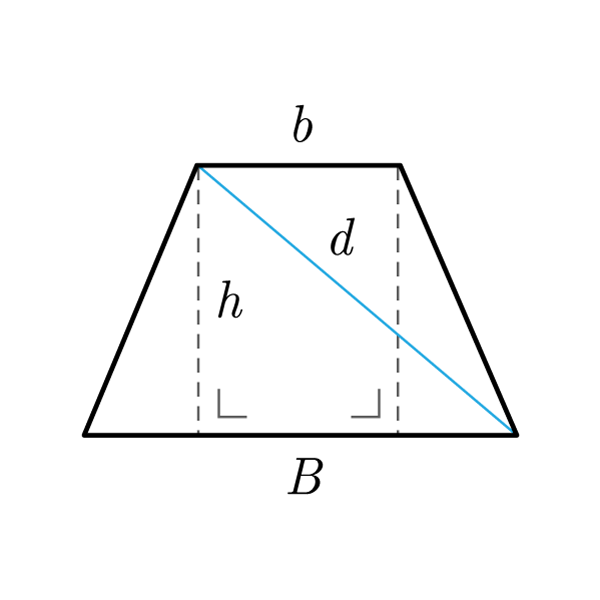|
|
|
$$2p = B + b + 2S$$
Perimeter
$$A = \frac{\left(B + b \right) \times h}{2}$$
Area
$$B + b = \frac{2A}{h}$$
Sum of bases
$$h = \frac{2A}{B + b}$$
Height
$$B + b = 2p - 2S$$
Sum of bases
$$S = \frac{2p - B - b}{2}$$
Oblique Side
$$p_{1} = \frac{ B - b }{2}$$
Oblique side Projection
$$B - b = 2 \times p_{1}$$
Difference of bases
$$B = b + 2p_{1}$$
Longer Base
$$b = B - 2p_{1}$$
Shorter Base
Right Tr. delimited by height - oblique side
$$S = \sqrt{ {p_{1}}^2 + {h}^2 }$$
Side (Pythagoras' theorem)
$$h = \sqrt{ {S}^2 - {p_{1}}^2 }$$
Height
$$p_{1} = \sqrt{ {S}^2 - {h}^2 }$$
Oblique side Projection
Definition
An isosceles trapezoid is a trapezoid with oblique sides congruent.
Properties
- The oblique sides are congruent
- The angles adjacent to their respective bases are congruent
- Diagonals are congruent
- All the Generic Trapezoid formulas are valid

Isosceles Trapezoid Formulas
| Data | Formula |
|---|---|
| Perimeter | 2p = B + b + 2 × S |
| Area | A = [(B + b) × h] / 2 |
| Height | h = (2 × A) / (B + b) |
| Oblique Side | S = (2p - B - b) / 2 |
| Oblique side Projection | p1 = (B - b) / 2 |
| Sum of bases | B + b = (2 × A) / h |
| Sum of bases | B + b = 2p - 2 × S |